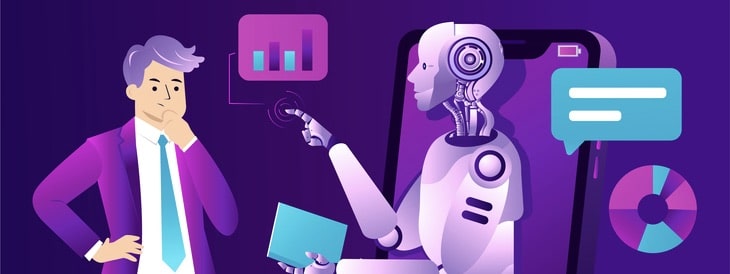In the landscape of public relations, digital assistants have emerged as game-changers. For media outreach professionals, understanding and leveraging these tools is no longer optional but essential. These sophisticated aids streamline processes, personalize pitches, and provide insights that were once beyond reach.
And so the question stands: How exactly are digital assistants reshaping the media outreach arena?
Whether you’re an industry veteran or new to the scene, grasping these shifts can mean the difference between a message that resonates and one that dissolves into the ether. Let’s explore this tech-induced transformation together.

Images created with Google Gemini
1) Streamlining workflow with automation
One of the most significant contributions of digital assistants in media outreach is their ability to automate routine tasks. This includes compiling media lists, sending follow-up emails, and scheduling social media posts.
By automating these processes, professionals can focus more on strategic activities like crafting compelling messages and building relationships with key journalists.
Digital assistants utilize algorithms to identify suitable contacts and outlets based on relevance, reach, and previous interactions. This means you’re not just shooting in the dark; your pitches are targeted and thus more likely to be successful.
Moreover, some digital tools are equipped with features that alert you when your brand is mentioned online, providing a timely opportunity for engagement.
2) Personalizing pitches with insights & data
The power of digital assistants lies in their proficiency in data analysis, which transforms generic pitches into tailored communications. These assistants can pull from vast databases of media consumption and response rates to inform the angles that might interest particular journalists or publications.
So for example, by using a voice command like, “Pull up recent statistics on urban mobility trends for my pitch to Tech Today,” instantly your assistant sifts through the latest data, equipping you with relevant figures and insights that ensure your pitch is both compelling and contextually appropriate.
This capability not only boosts the effectiveness of outreach efforts but also demonstrates a personalized approach that journalists appreciate.
3) Scheduling & managing outreach efforts
Digital assistants excel in streamlining the coordination and management of media outreach schedules. These tools can schedule meetings, send reminders for follow-ups, and even automate entire email sequences with precision—all through simple voice commands.
For instance, you could tell your assistant:
- “Schedule a follow-up email two days after my initial pitch to Editor Jane Doe.”
The assistant not only sets this task up but also tracks its completion and effectiveness. This automation frees up significant time which can be redirected towards more creative or critical thinking tasks within the outreach strategy, enhancing productivity without sacrificing personalization.
Think of it as having a tireless intern managing your schedule and outreach logistics. With the availability of platforms like Lindy, AI digital assistants can become an extension of your team, focusing on the administrative tasks while you focus on the strategic aspects.
4) Monitoring coverage and sentiment analysis
Digital assistants are invaluable for keeping a pulse on how your brand is perceived in the media. These tools can continuously monitor online mentions, news stories, and social media comments to provide real-time insights into audience sentiment.
Using voice commands like, “Show me the latest mentions of our brand on social platforms,” can instantly deliver a report detailing where and how your brand was discussed.
This ongoing monitoring allows you to quickly identify both positive accolades and potential issues before they escalate, offering a proactive approach to managing your public relations efforts effectively.
5) Leveraging digital assistants: strategies & considerations
Integrating digital assistants into your public relations strategy is more than a convenience – it’s a competitive advantage.
These tools enhance efficiency, but they also provide advanced analytics and personalized interaction capabilities that can drastically improve how you engage with media and manage relationships.
When choosing the right digital assistant for your PR needs, consider the following:
- Compatibility with existing systems
- Scalability as per your organization’s size and needs
- Specific features that align with your outreach strategies
Here are some key points to consider:
- Evaluate your needs: Understand the specific tasks you want to automate or streamline, such as media monitoring or outreach scheduling.
- Research options: Look for tools that offer robust integration with popular PR software and customizable features.
However, it’s important to address potential limitations and concerns:
- Accuracy of automation: Automated tasks should be regularly reviewed to ensure accuracy in communications.
- Data privacy: Always choose tools compliant with data protection regulations to safeguard the information of both your firm and the contacts within your network.
By mindfully selecting and implementing these assistants, you ensure they enhance rather than complicate your workflow.
6) Future trends in digital assistant technology for media outreach
The evolution of digital assistants is set to redefine media outreach strategies further. Here’s a look at some emerging trends that are shaping the future:
-
Multimodal learning:
The next wave of digital assistants will not only understand text or voice commands but also interpret visual data. This multimodal approach can analyze video content from press conferences or image-heavy social media posts, providing more comprehensive insights into media campaigns.
-
Focus on specific domains (business vs. personal):
As the capabilities of digital assistants enhance, we’re seeing a trend towards specialization. In 2024, expect tools tailored specifically for business environments, those that can streamline complex tasks like report automation and detailed schedule management for PR events.
This targeted functionality ensures that businesses can maximize efficiency in their specific operational contexts.
These advancements illustrate not just technological progression but a strategic refinement in how we utilize tools for better precision in public relations and beyond.
7) Emphasis on user privacy and security
With digital assistants increasingly embedded in both personal and business spheres, the focus is sharply turning towards enhancing user privacy and security. As these tools handle sensitive data, from media contacts to internal communications, the need for robust security measures has never been more critical.
Here are key developments in this area:
- Encryption protocols: Advanced encryption techniques are being integrated to ensure that all data exchanged through digital assistants remains secure from unauthorized access.
- Compliance with regulations: Digital assistants are being designed to comply with privacy standards such as GDPR and CCPA, ensuring safe handling of personal information.
- User control features: More control is being given to users over the data their assistants can access and share. This not only enhances trust but also allows users to customize privacy settings based on their specific needs.
These enhancements make it clear: as the utility of digital assistants grows, so does the imperative for stringent security protocols, safeguarding the reputation of businesses while protecting vital stakeholder information.
Conclusion: Navigating the new terrain with digital assistants
In the realm of media outreach, digital assistants are not just tools; they’re transformative allies that reshape how communications professionals engage with their audience and manage day-to-day operations.
From streamlining mundane tasks to personalizing pitches with precise data-driven insights, these technological aids enhance productivity and ensure messages hit the right mark.
However, as we harness their potential, it’s crucial to choose the right assistant tailored to specific needs while being mindful of privacy and security concerns. With thoughtful integration and strategic use, digital assistants can significantly bolster your media outreach efforts, making them an indispensable part of modern PR arsenals!








